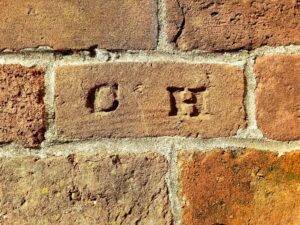
In the eternal quest historians undertake to date building construction, sometimes they turn to the common brick. Believe it or not we’ve had history professors visit the county who specialize in tracing the origin of bricks. In 1984 this same Kelley House Calendar column reported on Professor Margaret Henry of San Francisco State University dating bricks discovered around the Kelley House Museum.
Like any reusable building material, when the Museum was being remodeled and rebuilt, some bricks went back into its foundation, but others were used in walkways, as thresholds at the foot of outside stairs, and on the hearth of the fireplace inside the Kelley House dining room. But, if you’ve ever noticed, some bricks are imprinted with the name of the manufacturer. So, figuring out how the bricks that built the Kelley House got to Mendocino is an adventure in itself.
One way they got here was as ballast in sailing ships, and so there were bricks from Scotland and England that were unloaded from ships here in the harbors and then used in construction. There were also bricks that arrived from brickyards around the state. In 1981 Mendocino resident Barry Cusick let researchers investigate an old brick pile on his property. There were a dozen different imprints on those bricks, including ones from the cities of Stockton, Ione and Livermore.
Robert Piwarzyk, living in Little River in the 1990s, documented forty imprints of bricks found in Mendocino City. Some imprints could be traced: C.P.B. Co turned out to be Corona Pressed Brick Company in southern California, and Ione was in Amador County, but some bricks were marked with Atlas, or Gasco, and didn’t have enough clues to identify their source.
Brickyards in Mendocino County existed in Boonville, Philo, Glen Blair, Navarro, Fort Bragg, Ukiah, Talmadge and Potter Valley. The first was Remstead and Brown’s, east of Ukiah, where they made more than 200,000 bricks in 1865. The Elliot kiln in 1866 advertised the “finest quality” bricks for seven dollars per thousand bricks.
In 1882 Betz and Snuffin had a brickyard on Oak Street near Orr Creek and had 300,000 pressed bricks. They were used to build the County Courthouse in Ukiah. In 1890 Bartlett Brothers put up a brickyard near the proposed State Asylum Hospital and turned out one million of the eight million bricks needed for its construction.
The bricks at the Mendocino Presbyterian Church have been documented and found to originate in England, Redding, Stockton, Richmond and Carnegie (a ghost town). In brickmaking, lime was mixed with clay and that had to be imported to the coast. Good bricks were molded under pressure to squeeze out water and air, fired at high temperature and then cooked slowly in kilns. Firebrick, made from different materials than regular brick, was denser, did not absorb moisture and crumble, and was used in places that experienced high temperatures.
In the days where every structure had a fire of some sort for heating or cooking, conflagrations were common, burning down entire neighborhoods. Brick seemed like a better choice for building materials to overcome these tragedies, but unfortunately it didn’t stand up well to California’s frequent earthquakes. Many of Fort Bragg’s brick buildings collapsed during quakes, although Caspar’s brick structures mostly survived.
Mendocino City had local brick makers, the best-known being John Staudacher. One of his brickyards was located on Clay Hill, the area up Little Lake Road on the north side of the road near its intersection with Clark Road. In 1905, he was firing 50,000 bricks at a time in his kilns. Staudacher built many fireplaces and chimneys with his brick, including the square, one-million brick chimney for the Mendocino Lumber Company Mill down on Big River. Sadly, this enormous chimney collapsed when the 1906 Earthquake hit the area. It was replaced with a steel structure, but I’ll bet those million bricks were recycled locally into all sorts of things.
Up and down the coast, when brick structures like chimneys, steam boilers, incinerators, and dry kilns were torn down at mills in Glen Blair, Big River, Navarro and Greenwood/Elk, they found another purpose as walls, sidewalks, stairs, patios, fountains, well linings and fireplaces in newer structures.
Back at the Kelley House, there is a garden walk made from repurposed brick, and in that walk is one imprinted with two widely spaced letters, “C H.” Turns out this brick was made especially for San Francisco’s City Hall. In the 1870s, numerous manufacturers from San Francisco, San Rafael, San Jose, and Sacramento provided the bricks for the project and stamped them with C H, which stands for City Hall. This is unusual because most bricks are stamped with the maker’s name, not their destination. But how did this brick get to Mendocino?
The next time you are near some old bricks, look and see if there are names impressed on the them and write it down. With the help of the internet it may be possible to find out, like we did, where they were made. The Kelley House Museum has a whole folder of information in their archives on brick making…check it out!
The Kelley House Museum and Research Center is open Fridays through Mondays, 11:00 to 3:00. We’re located at 45007 Albion Street, Mendocino. Contact us at (707) 937-5791, or curator@KelleyHouseMuseum.org